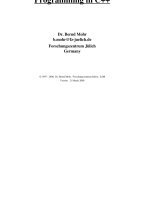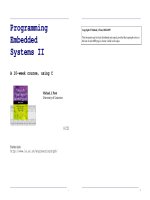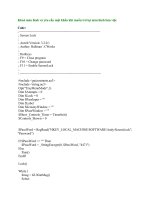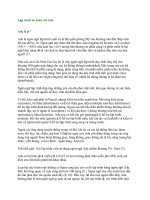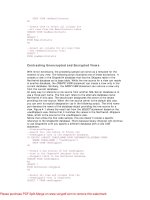Tài liệu Programming Android, 2nd Edition doc
Bạn đang xem bản rút gọn của tài liệu. Xem và tải ngay bản đầy đủ của tài liệu tại đây (7.34 MB, 564 trang )
www.it-ebooks.info
www.it-ebooks.info
SECOND EDITION
Programming Android
Zigurd Mednieks, Laird Dornin, G. Blake Meike,
and Masumi Nakamura
Beijing
•
Cambridge
•
Farnham
•
Köln
•
Sebastopol
•
Tokyo
www.it-ebooks.info
Programming Android, Second Edition
by Zigurd Mednieks, Laird Dornin, G. Blake Meike, and Masumi Nakamura
Copyright
© 2012 Zigurd Mednieks, Laird Dornin, Blake Meike, and Masumi Nakamura. All rights
reserved.
Printed in the United States of America.
Published by O’Reilly Media, Inc., 1005 Gravenstein Highway North, Sebastopol, CA 95472.
O’Reilly books may be purchased for educational, business, or sales promotional use. Online editions
are also available for most titles (). For more information, contact our
corporate/institutional sales department: 800-998-9938 or
Editors: Andy Oram and Rachel Roumeliotis
Production Editor: Melanie Yarbrough
Copyeditor: Audrey Doyle
Proofreader: Teresa Horton
Indexer: Ellen Troutman-Zaig
Cover Designer: Karen Montgomery
Interior Designer: David Futato
Illustrator: Robert Romano
September 2012: Second Edition.
Revision History for the Second Edition:
2012-09-26
First release
See for release details.
Nutshell Handbook, the Nutshell Handbook logo, and the O’Reilly logo are registered trademarks of
O’Reilly Media, Inc. Programming Android, Second Edition, the cover image of a pine grosbeak, and
related trade dress are trademarks of O’Reilly Media, Inc.
Many of the designations used by manufacturers and sellers to distinguish their products are claimed as
trademarks. Where those designations appear in this book, and O’Reilly Media, Inc., was aware of a
trademark claim, the designations have been printed in caps or initial caps.
While every precaution has been taken in the preparation of this book, the publisher and authors assume
no responsibility for errors or omissions, or for damages resulting from the use of the information con-
tained herein.
ISBN: 978-1-449-31664-8
[LSI]
1348682639
www.it-ebooks.info
Table of Contents
Preface .
. . . . . . . . . . . . . . . . . . . . . . . . . . . . . . . . . . . . . . . . . . . . . . . . . . . . . . . . . . . . . . . . . . . xiii
Part I. Tools and Basics
1. Installing the Android SDK and Prerequisites .
. . . . . . . . . . . . . . . . . . . . . . . . . . . . . . . 3
Installing the Android SDK and Prerequisites 3
The Java Development Kit (JDK) 4
The Eclipse Integrated Development Environment (IDE) 5
The Android SDK 7
Adding Build Targets to the SDK 8
The Android Developer Tools (ADT) Plug-in for Eclipse 9
Test Drive: Confirm That Your Installation Works 12
Making an Android Project 12
Making an Android Virtual Device (AVD) 16
Running a Program on an AVD 19
Running a Program on an Android Device 20
Troubleshooting SDK Problems: No Build Targets 21
Components of the SDK 21
The Android Debug Bridge (adb) 21
The Dalvik Debug Monitor Server (DDMS) 21
Components of the ADT Eclipse Plug-in 23
Android Virtual Devices 25
Other SDK Tools 26
Keeping Up-to-Date 27
Keeping the Android SDK Up-to-Date 28
Keeping Eclipse and the ADT Plug-in Up-to-Date 28
Keeping the JDK Up-to-Date 29
Example Code 30
SDK Example Code 30
Example Code from This Book 30
On Reading Code 31
iii
www.it-ebooks.info
2. Java for Android . . . . . . . . . . . . . . . . . . . . . . . . . . . . . . . . . . . . . . . . . . . . . . . . . . . . . . . 33
Android Is Reshaping Client-Side Java 33
The Java Type System 34
Primitive Types 34
Objects and Classes 35
Object Creation 35
The Object Class and Its Methods 37
Objects, Inheritance, and Polymorphism 39
Final and Static Declarations 41
Abstract Classes 45
Interfaces 46
Exceptions 48
The Java Collections Framework 51
Garbage Collection 55
Scope 55
Java Packages 56
Access Modifiers and Encapsulation 57
Idioms of Java Programming 59
Type Safety in Java 59
Using Anonymous Classes 62
Modular Programming in Java 64
Basic Multithreaded Concurrent Programming in Java 67
Synchronization and Thread Safety 68
Thread Control with wait() and notify() Methods 71
Synchronization and Data Structures 72
3. The Ingredients of an Android Application . . . . . . . . . . . . . . . . . . . . . . . . . . . . . . . . . 75
Traditional Programming Models Compared to Android 75
Activities, Intents, and Tasks 77
Other Android Components 79
Service 79
Content Providers 80
BroadcastReceiver 83
Component Life Cycles 83
The Activity Life Cycle 83
On Porting Software to Android 85
Static Application Resources and Context 86
Organizing Java Source 87
Resources 88
Application Manifests 90
Initialization Parameters in AndroidManifest.xml 91
Packaging an Android Application: The .apk File 94
The Android Application Runtime Environment 94
iv | Table of Contents
www.it-ebooks.info
The Dalvik VM 95
Zygote: Forking a New Process 95
Sandboxing: Processes and Users 95
The Android Libraries 96
Extending Android 98
The Android Application Template 98
Overrides and Callbacks 99
Polymorphism and Composition 101
Extending Android Classes 102
Concurrency in Android 104
AsyncTask and the UI Thread 105
Threads in an Android Process 116
Serialization 118
Java Serialization 119
Parcelable 120
Classes That Support Serialization 124
Serialization and the Application Life Cycle 125
4. Getting Your Application into Users’ Hands .
. . . . . . . . . . . . . . . . . . . . . . . . . . . . . . . 127
Application Signing 127
Public Key Encryption and Cryptographic Signing 127
How Signatures Protect Software Users, Publishers, and
Secure Communications 129
Signing an Application 130
Placing an Application for Distribution in the Android Market 135
Becoming an Official Android Developer 135
Uploading Applications in the Market 136
Getting Paid 138
Alternative Distribution 139
Verizon Applications for Android 139
Amazon Applications for Android 141
Google Maps API Keys 143
Specifying API-Level Compatibility 144
Compatibility with Many Kinds of Screens 144
Testing for Screen Size Compatibility 145
Resource Qualifiers and Screen Sizes 145
5. Eclipse for Android Software Development .
. . . . . . . . . . . . . . . . . . . . . . . . . . . . . . . 147
Eclipse Concepts and Terminology 148
Plug-ins 148
Workspaces 149
Java Environments 150
Projects 151
Table of Contents | v
www.it-ebooks.info
Builders and Artifacts 151
Extensions 151
Associations 153
Eclipse Views and Perspectives 153
The Package Explorer View 154
The Task List View 154
The Outline View 155
The Problems View 155
Java Coding in Eclipse 156
Editing Java Code and Code Completion 156
Refactoring 156
Eclipse and Android 158
Preventing Bugs and Keeping Your Code Clean 158
Static Analyzers 158
Applying Static Analysis to Android Code 163
Limitations of Static Analysis 166
Eclipse Idiosyncrasies and Alternatives 166
Part II. About the Android Framework
6. Building a View . . . . . . . . . . . . . . . . . . . . . . . . . . . . . . . . . . . . . . . . . . . . . . . . . . . . . . . 171
Android GUI Architecture 171
The Model 171
The View 172
The Controller 173
Putting It Together 173
Assembling a Graphical Interface 175
Wiring Up the Controller 180
Listening to the Model 182
Listening for Touch Events 187
Multiple Pointers and Gestures 190
Listening for Key Events 192
Choosing an Event Handler 193
Advanced Wiring: Focus and Threading 195
The Menu and the Action Bar 199
View Debugging and Optimization 202
7. Fragments and Multiplatform Support .
. . . . . . . . . . . . . . . . . . . . . . . . . . . . . . . . . . 205
Creating a Fragment 206
Fragment Life Cycle 209
The Fragment Manager 210
Fragment Transactions 211
vi | Table of Contents
www.it-ebooks.info
The Support Package 216
Fragments and Layout 217
8. Drawing 2D and 3D Graphics . . . . . . . . . . . . . . . . . . . . . . . . . . . . . . . . . . . . . . . . . . . . 225
Rolling Your Own Widgets 225
Layout 226
Canvas Drawing 231
Drawables 242
Bitmaps 247
Bling 248
Shadows, Gradients, Filters, and Hardware Acceleration 251
Animation 253
OpenGL Graphics 258
9. Handling and Persisting Data . . . . . . . . . . . . . . . . . . . . . . . . . . . . . . . . . . . . . . . . . . . 263
Relational Database Overview 263
SQLite 264
The SQL Language 264
SQL Data Definition Commands 265
SQL Data Manipulation Commands 268
Additional Database Concepts 270
Database Transactions 271
Example Database Manipulation Using sqlite3 271
SQL and the Database-Centric Data Model for Android Applications 275
The Android Database Classes 276
Database Design for Android Applications 277
Basic Structure of the SimpleVideoDbHelper Class 277
Using the Database API: MJAndroid 280
Android and Social Networking 280
The Source Folder (src) 282
Loading and Starting the Application 283
Database Queries and Reading Data from the Database 283
Modifying the Database 287
Part III. A Skeleton Application for Android
10. A Framework for a Well-Behaved Application .
. . . . . . . . . . . . . . . . . . . . . . . . . . . . . 295
Visualizing Life Cycles 296
Visualizing the Activity Life Cycle 296
Visualizing the Fragment Life Cycle 308
The Activity Class and Well-Behaved Applications 311
The Activity Life Cycle and the User Experience 311
Table of Contents | vii
www.it-ebooks.info
Life Cycle Methods of the Application Class 312
11. Building a User Interface . . . . . . . . . . . . . . . . . . . . . . . . . . . . . . . . . . . . . . . . . . . . . . . 315
Top-Level Design 316
Fragment, Activity, and Scalable Design 317
Visual Editing of User Interfaces 319
Starting with a Blank Slate 319
Laying Out the Fragments 323
Lay Out Fragments Using the Visual Editor 324
Multiple Layouts 325
Folding and Unfolding a Scalable UI 326
Decisions about Screen Size and Resolution 326
Delegating to Fragment Classes 330
Making Activity, Fragment, Action Bar, and Multiple Layouts Work To-
gether 333
Action Bar 333
Tabs and Fragments 333
The Other Activity 336
12. Using Content Providers .
. . . . . . . . . . . . . . . . . . . . . . . . . . . . . . . . . . . . . . . . . . . . . . 341
Understanding Content Providers 342
Implementing a Content Provider 343
Browsing Video with Finch 344
Defining a Provider Public API 345
Defining the CONTENT_URI 346
Creating the Column Names 348
Declaring Column Specification Strings 348
Writing and Integrating a Content Provider 350
Common Content Provider Tasks 350
File Management and Binary Data 352
Android MVC and Content Observation 354
A Complete Content Provider: The SimpleFinchVideoContentProvider
Code 355
The SimpleFinchVideoContentProvider Class and Instance Variables 355
Implementing the onCreate Method 357
Implementing the getType Method 358
Implementing the Provider API 358
Determining How Often to Notify Observers 363
Declaring Your Content Provider 363
13. A Content Provider as a Facade for a RESTful Web Service .
. . . . . . . . . . . . . . . . . . . 365
Developing RESTful Android Applications 366
A “Network MVC” 367
viii | Table of Contents
www.it-ebooks.info
Summary of Benefits 369
Code Example: Dynamically Listing and Caching YouTube
Video Content 370
Structure of the Source Code for the Finch YouTube Video Example 371
Stepping Through the Search Application 372
Step 1: Our UI Collects User Input 373
Step 2: Our Controller Listens for Events 373
Step 3: The Controller Queries the Content Provider with a managedQuery
on the Content Provider/Model 374
Step 4: Implementing the RESTful Request 374
Constants and Initialization 375
Creating the Database 375
A Networked Query Method 375
insert and ResponseHandlers 388
File Management: Storing Thumbnails 390
Part IV. Advanced Topics
14. Search . . . . . . . . . . . . . . . . . . . . . . . . . . . . . . . . . . . . . . . . . . . . . . . . . . . . . . . . . . . . . . 395
Search Interface 395
Search Basics 395
Search Dialog 402
Search Widget 403
Query Suggestions 404
Recent Query Suggestions 404
Custom Query Suggestions 405
15. Location and Mapping . . . . . . . . . . . . . . . . . . . . . . . . . . . . . . . . . . . . . . . . . . . . . . . . . 411
Location-Based Services 412
Mapping 413
The Google Maps Activity 413
The MapView and MapActivity 414
Working with MapViews 415
MapView and MyLocationOverlay Initialization 415
Pausing and Resuming a MapActivity 418
Controlling the Map with Menu Buttons 419
Controlling the Map with the Keypad 421
Location Without Maps 422
The Manifest and Layout Files 422
Connecting to a Location Provider and Getting Location Updates 423
Updating the Emulated Location 426
StreetView 430
Table of Contents | ix
www.it-ebooks.info
16. Multimedia . . . . . . . . . . . . . . . . . . . . . . . . . . . . . . . . . . . . . . . . . . . . . . . . . . . . . . . . . . 433
Audio and Video 433
Playing Audio and Video 434
Audio Playback 435
Video Playback 437
Recording Audio and Video 438
Audio Recording 439
Video Recording 442
Stored Media Content 443
17. Sensors, NFC, Speech, Gestures, and Accessibility . . . . . . . . . . . . . . . . . . . . . . . . . . . 445
Sensors 445
Position 447
Other Sensors 449
Near Field Communication (NFC) 450
Reading a Tag 451
Writing to a Tag 457
P2P Mode and Beam 459
Gesture Input 461
Accessibility 463
18. Communication, Identity, Sync, and Social Media .
. . . . . . . . . . . . . . . . . . . . . . . . . 467
Account Contacts 467
Authentication and Synchronization 470
Authentication 471
Synchronization 478
Bluetooth 485
The Bluetooth Protocol Stack 485
BlueZ: The Linux Bluetooth Implementation 487
Using Bluetooth in Android Applications 487
19. The Android Native Development Kit (NDK) .
. . . . . . . . . . . . . . . . . . . . . . . . . . . . . . 501
Native Methods and JNI Calls 502
Conventions in Native Method Calls 502
Conventions on the Java Side 503
The Android NDK 504
Setting Up the NDK Environment 504
Editing C/C++ Code in Eclipse 504
Compiling with the NDK 505
JNI, NDK, and SDK: A Sample App 506
Native Libraries and Headers Provided by the NDK 507
Building Your Own Custom Library Modules 509
Native Activities 512
x | Table of Contents
www.it-ebooks.info
Index . . . . . . . . . . . . . . . . . . . . . . . . . . . . . . . . . . . . . . . . . . . . . . . . . . . . . . . . . . . . . . . . . . . . . 519
Table of Contents | xi
www.it-ebooks.info
www.it-ebooks.info
Preface
The purpose of this book is to enable you to create well-engineered Android applica-
tions that go beyond the scope of small example applications.
This book is for people coming to Android programming from a variety of backgrounds.
If you have been programming iPhone or Mac OS applications in Objective-C, you will
find coverage of Android tools and Java language features relevant to Android pro-
gramming that will help you bring your knowledge of mobile application development
to Android. If you are an experienced Java coder, you will find coverage of Android
application architecture that will enable you to use your Java expertise in this newly
vibrant world of client Java application development. In short, this is a book for people
with some relevant experience in object-oriented languages, mobile applications, REST
applications, and similar disciplines who want to go further than an introductory book
or online tutorials will take them.
How This Book Is Organized
We want to get you off to a fast start. The chapters in the first part of this book will
step you through using the SDK tools so that you can access example code in this book
and in the SDK, even as you expand your knowledge of SDK tools, Java, and database
design. The tools and basics covered in the first part might be familiar enough to you
that you would want to skip to Part II where we build foundational knowledge for
developing larger Android applications.
The central part of this book is an example of an application that uses web services to
deliver information to the user—something many applications have at their core. We
present an application architecture, and a novel approach to using Android’s frame-
work classes that enables you to do this particularly efficiently. You will be able to use
this application as a framework for creating your own applications, and as a tool for
learning about Android programming.
In the final part of this book, we explore Android APIs in specific application areas:
multimedia, location, sensors, and communication, among others, in order to equip
you to program applications in your specific area of interest.
xiii
www.it-ebooks.info
By the time you reach the end of this book, we want you to have gained knowledge
beyond reference material and a walk-through of examples. We want you to have a
point of view on how to make great Android applications.
Conventions Used in This Book
The following typographical conventions are used in this book:
Italic
Indicates new terms, URLs, email addresses, filenames, and file extensions
Constant width
Used for program listings, as well as within paragraphs to refer to program elements
such as variable or function names, databases, data types, environment variables,
statements, and keywords
Constant width bold
Shows commands or other text that should be typed literally by the user
Constant width italic
Shows text that should be replaced with user-supplied values or by values deter-
mined by context
This icon signifies a tip, suggestion, or general note.
This icon indicates a warning or caution.
Using Code Examples
This
book is here to help you get your job done. In general, you may use the code in
this book in your programs and documentation. You do not need to contact us for
permission unless you’re reproducing a significant portion of the code. For example,
writing a program that uses several chunks of code from this book does not require
permission. Selling or distributing a CD-ROM of examples from O’Reilly books does
require permission. Answering a question by citing this book and quoting example
code does not require permission. Incorporating a significant amount of example code
from this book into your product’s documentation does require permission.
We appreciate, but do not require, attribution. An attribution usually includes the
title, author, publisher, and ISBN. For example: “Programming Android, Second
xiv | Preface
www.it-ebooks.info
Edition by Zigurd Mednieks, Laird Dornin, G. Blake Meike, and Masumi Nakamura.
Copyright 2012 O’Reilly Media, Inc., 978-1-449-31664-8.”
If you feel your use of code examples falls outside fair use or the permission given here,
feel free to contact us at
Safari® Books Online
Safari Books Online (www.safaribooksonline.com) is an on-demand digital
library that delivers expert content in both book and video form from the
world’s leading authors in technology and business.
Technology professionals, software developers, web designers, and business and cre-
ative professionals use Safari Books Online as their primary resource for research,
problem solving, learning, and certification training.
Safari Books Online offers a range of product mixes and pricing programs for organi-
zations, government agencies, and individuals. Subscribers have access to thousands
of books, training videos, and prepublication manuscripts in one fully searchable da-
tabase from publishers like O’Reilly Media, Prentice Hall Professional, Addison-Wesley
Professional, Microsoft Press, Sams, Que, Peachpit Press, Focal Press, Cisco Press, John
Wiley & Sons, Syngress, Morgan Kaufmann, IBM Redbooks, Packt, Adobe Press, FT
Press, Apress, Manning, New Riders, McGraw-Hill, Jones & Bartlett, Course Tech-
nology, and dozens more. For more information about Safari Books Online, please visit
us online.
How to Contact Us
Please address comments and questions concerning this book to the publisher:
O’Reilly Media, Inc.
1005 Gravenstein Highway North
Sebastopol, CA 95472
800-998-9938 (in the United States or Canada)
707-829-0515 (international or local)
707-829-0104 (fax)
We have a web page for this book, where we list errata, examples, and any additional
information. You can access this page at />To comment or
ask technical questions about this book, send email to
For more information about our books, courses, conferences, and news, see our website
at .
Find us on Facebook: />Preface | xv
www.it-ebooks.info
Follow us on Twitter: />Watch us on YouTube: />Acknowledgments
The authors have adapted portions of this book from their previously released title,
Android Application Development (O’Reilly).
Drafts of this book were released on the O’Reilly Open Feedback Publishing System
(OFPS) in order to get your feedback on whether and how we are meeting the goals for
this book. We are very grateful for the readers who participated in OFPS, and we owe
them much in correcting our errors and improving our writing. Open review of drafts
will be part of future editions, and we welcome your views on every aspect of this book.
Zigurd Mednieks
I am eternally grateful to Terry, my wife, and Maija and Charles, my children, who gave
me the time to do this. This book exists because our agent, Carole Jelen, at Waterside
Productions, whipped our proposal material into shape, and because Mike Hendrick-
son kicked off the project within O’Reilly. Brian Jepson and Andy Oram, our editors,
kept this large troupe of authors unified in purpose and result. Thanks to Johan van
der Hoeven, who provided review comments that contributed much to accuracy and
clarity. Thanks to all the reviewers who used the Open Feedback Publishing System to
help make this a better book.
Laird Dornin
Thanks to my wonderful Norah for encouraging me to take part in this project, even
though you had no idea of the amount of effort involved in writing a book. Cheers to
trips to Acadia, trips to New Hampshire, and late nights writing. I’m glad this book
did not stall our truly important project, the arrival of our beautiful daughter Claire.
Thanks to Andy our editor, and my coauthors for giving me this opportunity. Thanks
to Larry for reviewing and enabling me to work on this project. I’m glad that ideas I
developed at SavaJe could find a voice in this book. Finally, thanks to our main re-
viewers Vijay and Johan, you both found solid ways to improve the content.
G. Blake Meike
My thanks to our agent, Carole Jelen, Waterside Productions, without whom this book
would never have been more than a good idea. Thanks, also, to editors Brian Jepson
and Andy Oram, masters of the “gentle way.” Everyone who reads this book benefits
from the efforts of Johan van der Hoeven and Vijay Yellapragada, technical reviewers;
Sumita Mukherji, Adam Zaremba, and the rest of the O’Reilly production team; and
all those who used O’Reilly’s OFPS to wade through early and nearly incomprehensible
drafts, to produce salient comments and catch egregious errors. Thanks guys! Speaking
of “thanks guys,” it was quite an honor and certainly a pleasure to collaborate with my
coauthors, Zigurd, Laird, and Masumi. Of course, last, best, and as ever, thanks and
xvi | Preface
www.it-ebooks.info
love to my wife Catherine, who challenges me in the good times and provides support
when it’s dark. Yeah, I know, the bookcase still isn’t done.
Masumi Nakamura
I would like to thank my friends and family for bearing with me as I worked on this
and other projects. An especially big thank you to Jessamyn for dealing with me all
these years. I also would like to thank Brian and Andy for getting us through the fine
points of writing and publishing, as well as my coauthors for bringing me in to work
on this piece. Also, a quick shout out to all the people at WHERE, Inc. who have been
very supportive in my technological wanderings. Finally, a thank you to you, the read-
ers, and all you developers working tirelessly to make Android a great platform to work
on and enjoy using.
Preface | xvii
www.it-ebooks.info
www.it-ebooks.info
PART I
Tools and Basics
Part I shows you how to install and use your tools, what you need to know about Java
to write good Android code, and how to design and use SQL databases, which are
central to the Android application model, persistence system, and implementation of
key design patterns in Android programs.
www.it-ebooks.info
www.it-ebooks.info
CHAPTER 1
Installing the Android
SDK and Prerequisites
This chapter shows you how to install the Android software development kit (SDK)
and all the related software you’re likely to need. By the end, you’ll be able to run a
simple “Hello World” program on an emulator. Windows, Mac OS X, and Linux sys-
tems can all be used for Android application development. We will load the software,
introduce you to the tools in the SDK, and point you to sources of example code.
Throughout this book, and especially in this chapter, we refer to instructions available
on various websites for installing and updating the tools you will use for creating An-
droid programs. The most important place to find information and links to tools is the
Android Developers site:
Our focus is on guiding you through installation, with explanations that will help you
understand how the parts of Android and its developer tools fit together, even as the
details of each part change.
Installing the Android SDK and Prerequisites
Successfully installing the Android SDK requires two other software systems that are
not part of the Android SDK: the Java Development Kit (JDK) and the Eclipse integrated
development environment (IDE). These two systems are not delivered as part of the
Android SDK because you may be using them for purposes outside of Android software
development, or because they may already be installed on your system, and redundant
installations of these systems can cause version clashes.
The Android SDK is compatible with a range of recent releases of the JDK and the
Eclipse IDE. Installing the current release of each of these tools will usually be the right
choice. The exact requirements are specified on the “System requirements” page of the
Android Developers site: />3
www.it-ebooks.info
One can use IDEs other than Eclipse in Android software development, and informa-
tion on using other IDEs is provided in the Android documentation at http://developer
.android.com/guide/developing/other-ide.html. We chose Eclipse as the IDE covered in
this book because Eclipse supports the greatest number of Android SDK tools and other
plug-ins, and Eclipse is the most widely used Java IDE, but IntelliJ IDEA is an alternative
many Java coders prefer.
The Java Development Kit (JDK)
If your system has an up-to-date JDK installed, you won’t need to install it again. The
JDK provides tools, such as the Java compiler, used by IDEs and SDKs for developing
Java programs. The JDK also contains a Java Runtime Environment (JRE), which en-
ables Java programs, such as Eclipse, to run on your system.
If you are using a Macintosh running a version of Mac OS X supported by the Android
SDK, the JDK is already installed.
If you are a Linux or Windows user, or you need to install the JDK from Oracle’s site
for some other reason, you can find the JDK at />java/javase/downloads/index.html.
The Windows installer you download is an executable file. Run the executable installer
file to install the JDK.
Linux users will need to extract the JDK folder they downloaded into their home di-
rectory, and perform the following steps to install the JDK. These steps assume you
want to use the current Oracle JDK as your default Java runtime:
Download the archive or package corresponding to your system. (If it is a package, use
the package manager to complete the installation; otherwise, follow these steps.)
tar -xvf archive-name.tar.gz
The JDK archive will be extracted into the ./jdk-name directory. Now move the JDK
directory to /usr/lib:
sudo mv ./jdk-name /usr/lib/jvm/jdk-name
Moving the JDK to that location makes it a configurable alternative in your Linux
environment, which is useful if you have projects or programs that require other ver-
sions of the JRE or JDK. Now run:
sudo update-alternatives install "/usr/bin/java" "java" \
"/usr/lib/jvm/jdk-name/bin/java" 1
sudo update-alternatives install "/usr/bin/javac" "javac" \
"/usr/lib/jvm/jdk-name.0/bin/javac" 1
sudo update-alternatives install "/usr/bin/javaws" "javaws" \
"/usr/lib/jvm/jdk-name/bin/javaws" 1
sudo update-alternatives config java
4 | Chapter 1: Installing the Android SDK and Prerequisites
www.it-ebooks.info
You will see output similar to that shown here:
There are 3 choices for the alternative java (providing /usr/bin/java).
Selection Path Priority Status
* 0 /usr/lib/jvm/java-6-openjdk/jre/bin/java 63 auto mode
1 /usr/lib/jvm/java-6-openjdk/jre/bin/java 63 manual mode
2 /usr/lib/jvm/java-6-sun/jre/bin/java 63 manual mode
3 /usr/lib/jvm/jdk1.7.0/jre/bin/java 1 manual mode
Press enter to keep the current choice[*], or type selection number:
When you select the JDK you are installing, you will see output like this:
update-alternatives: using /usr/lib/jvm/jdk1.7.0/jre/bin/java to provide
/usr/bin/java (java) in manual mode.
Repeat the preceding selection process for javac:
sudo update-alternatives config javac
And for javaws:
sudo update-alternatives config javaws
Depending
on the different kinds of Java implementations installed on your system,
and the current version of the JDK available when you read this, version numbers may
differ from what you see in examples of command output here.
For every OS, you can now check the version of Java installed with this command:
java -version
The version reported should correspond to the version you installed. If not, repeat the
installation steps, and make sure that no errors are reported during installation.
The Eclipse Integrated Development Environment (IDE)
Eclipse is a general-purpose technology platform. It has been applied to a variety of
uses in creating IDEs for multiple languages and in creating customized IDEs for many
specialized SDKs, as well as to uses outside of software development tools, such as
providing a Rich Client Platform (RCP) for Lotus Notes and a few other applications.
Eclipse is usually used as an IDE for writing, testing, and debugging software, especially
Java software. There are also several derivative IDEs and SDKs for various kinds of Java
software development based on Eclipse. In this case, you will take a widely used Eclipse
package and add a plug-in to it to make it usable for Android software development.
Let’s get that Eclipse package and install it.
Eclipse can be downloaded from />You will see a selection of the most commonly used Eclipse packages on this page. An
Eclipse “package” is a ready-made collection of Eclipse modules that make Eclipse
Installing the Android SDK and Prerequisites | 5
www.it-ebooks.info
